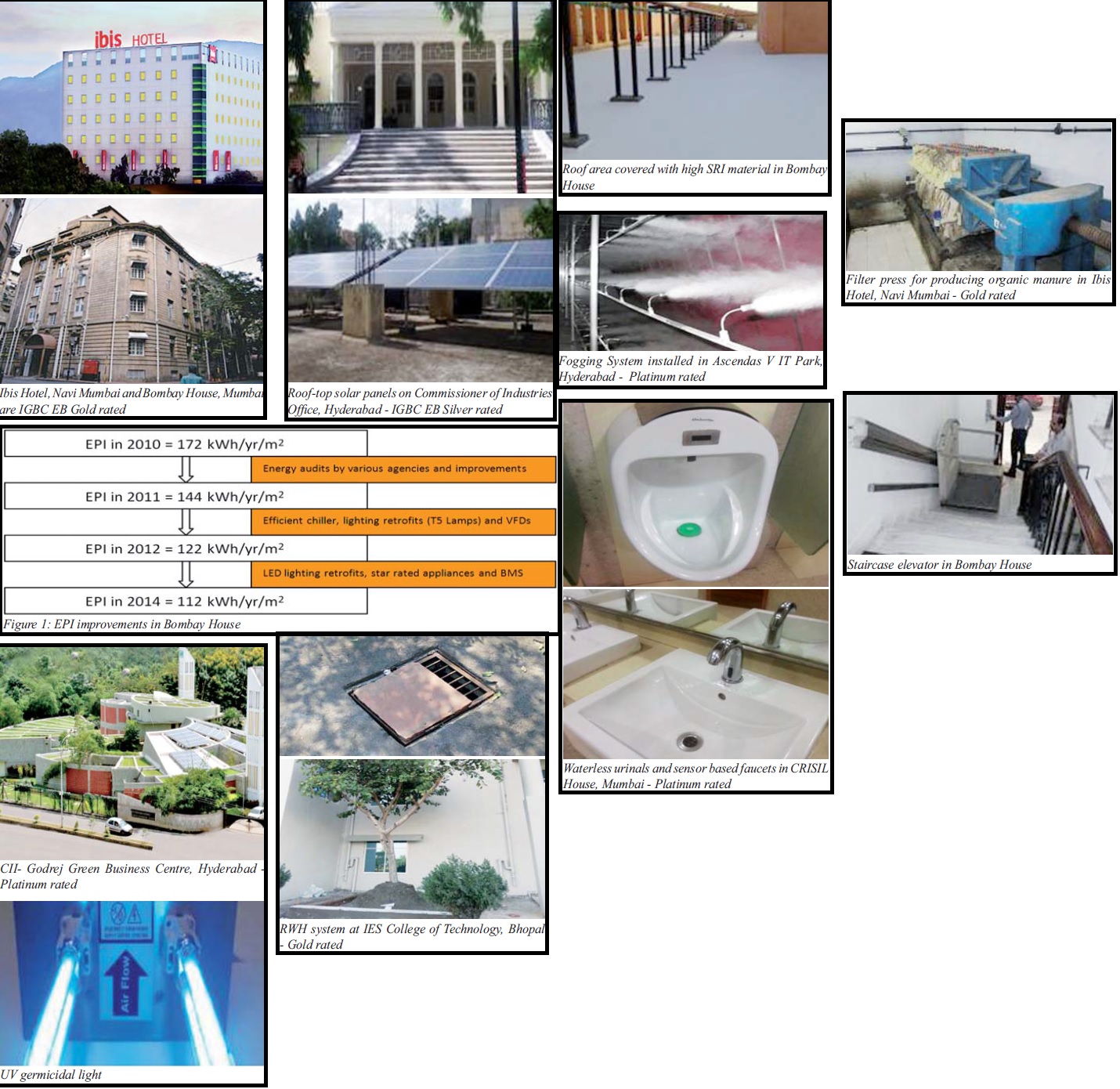Introduction
There is a growing need to introduce green building concepts in existing building stock to help preserve our precious natural resources of energy, fresh water and fresh air. There is enormous scope for greening of existing buildings. While new buildings have improved considerably in their environmental performance in recent years, existing recently-built buildings of the same size and function have been consuming large amounts of energy, water and other resources. Existing buildings encompass a large footprint of built environment, hence it is important to initiate retrofits
to minimize their energy and water consumption, channelize resources to balance the consumption and reduce their cost of operation. Green practices in existing buildings can help address national priorities including water efficiency, energy efficiency, reduction in fossil fuel use in commuting, handling of waste and conserving other natural resources. Most importantly, these concepts can enhance occupant health, happiness and well-being. In addition, they also bring large benefits to the owner with minimal payback period.
Green Existing Building Rating System
Against this background, the Indian Green Building Council (IGBC) has launched ‘IGBC Green Existing Building Operations and Maintenance Rating System’. This is the first rating system of its kind in India to address sustainability in Existing Buildings (EB), viz. corporate offices, administration
blocks, educational institutions, airports, hotels, hospitals, retail and others.
The benefits of IGBC Green Rating for Existing Buildings include:
• Energy savings of 30-40 %
• Water savings of 20-30%
• Health and well being of occupants
• Higher productivity
• Lower attrition
• Lower absenteeism
• Demonstration of commitment to environmental stewardship and corporate social responsibility.
Best Practices in IGBC Rated Green EB Projects
Today, various types of existing buildings are going the Green way. Highlights of some of the green practices incorporated in IGBC rated Existing Buildings across the country are presented below.
Off -Site Renewable Energy (Green Power)
Bombay House - the headquarters of Tata Group - has the unique distinction of being India’s first IGBC rated EB project. Bombay House has invested extensively in off -site renewable energy. As part of this initiative, Bombay House has purchased Renewable Energy Certificates of 1,065
MWh, equivalent to 75% of its total annual energy consumption.
On-Site Renewable Energy
A Government heritage project has set an example for renewable energy installation on its roof-top. Commissioner of Industries Office, Hyderabad, has installed roof-top solar panels with a capacity of 5 kw, catering to 11% of its total energy consumption.
Energy Efficiency
One of the significant benefits of going Green is energy saving. For instance, by retrofitting various energy systems, Bombay House has made substantial improvement in its Energy Performance Index (EPI), as shown in Figure 1. The building is further retrofitting its energy systems in a phased manner to achieve the lowest possible EPI.
Reduced Heat Island Effect on Roof
Bombay House has more than 95% of the roof area covered with High SRI paint mortar and China mosaic tiles.
Fogging System
Ascendas V IT Park, Hyderabad installed a fogging system to reduce the cooling requirement for their project having aircooled chillers. Cooling energy savings to the tune of 10% were achieved.
Thermal Imaging for Energy Efficiency
Thermal imaging survey of building fabric identifies air leaks in or out of the building, and also shows thermal insulation defects. Thermal imaging of
electrical system and building fabric has been carried out at Ascendas V IT Park, Hyderabad.
Water Efficient Fixtures
CRISIL House in Mumbai has achieved 89% savings in fresh water consumption through the use of water efficient flow fixtures and reuse of treated waste water.
Rain Water Harvesting
IES College of Technology, Bhopal has successfully put in place a rain water harvesting (RWH) system by installing recharge wells with the capacity to capture 86% of run-off volumes from roof and nonroof areas. The RWH system effectively captures 280 cubic meter of rain water.
Phytoremediation: Biological Treatment System for Waste Water
Commissioner of Industries Office, Hyderabad has installed Phytoremediation system with a capacity of 3 kld. Plant species grown in the system include Canna Indica, Heliconia and Alacaria. Phytoremediation involves the use of green plants for in-situ risk reduction and removal of contaminants from soil, water, sediments and air. It also adds aesthetics to the site.
Enhanced Indoor Air Quality
CII-Godrej GBC Building has installed UV germicidal lamps for air handling unit cooling coils. A germicidal lamp produces short-wave ultraviolet light (UVC), which disrupts bacterial activity in the air and disinfects it. Studies have shown that bacterial count in the indoor environment of this building is negligible. In-house Production of Organic
Fertilizers
Ibis Hotel, Navi Mumbai uses an inhouse generated by-product of Sewage Treatment Plant (STP) as organic fertilizer for landscaping purposes.
Waste Management, Organic Farming
Candor International School in Bangalore has taken various steps for waste segregation at the classroom level. The school maintains an organic farm, whose fertilizer requirements are met by utilizing the organic waste generated in the campus.
Facilities for Differently-abled People
Efforts have been made to convert Bombay House into a Universal Building by providing various facilities to differentlyabled people.
Some of the facilities are:
• Staircase elevator
• Ramps at entrance
• Specially designed toilets
• Braille system in lifts
Neighbourhood Preservation
IGBC projects, as part of their Beyond the Fence initiative, have adopted parks and conservation sites nearby for maintenance and preservation. On these lines, Bombay House has adopted parks like Horniman Circle and Jamsetji Statue Park.
Conclusion
IGBC Green Existing Building Rating System encourages both historical and recently built commercial buildings go the green way, and in the process plays a catalytic role in addressing National priorities. The need of the hour is to aggressively promote existing buildings go green and facilitate a greener and healthier India. IGBC works with all the stakeholders to help India emerge as the global leader in Green Buildings.
Disclaimer: The information provided within this publication / eBook/ content is for general informational purposes only. While we try to keep the information up-to-date and correct, there are no representations or warranties, express or implied, about the completeness, accuracy, reliability, suitability or availability with respect to the information, products, services, or related graphics contained in this publication / eBook/ content for any purpose. Any use of this information is at your own risk.
 Youth
Youth
 Women
Women
 Research for Ishrae
Research for Ishrae







